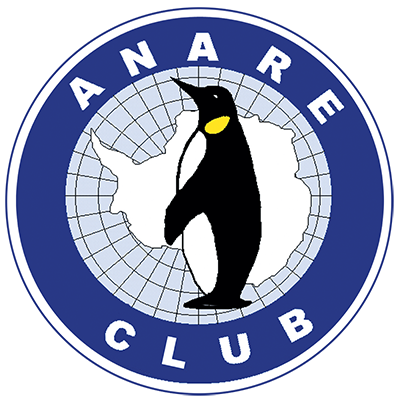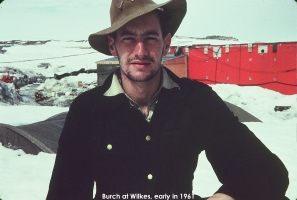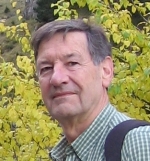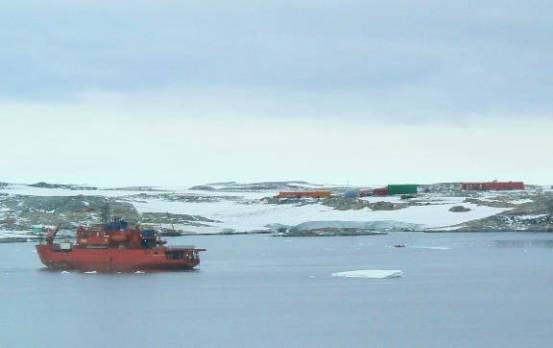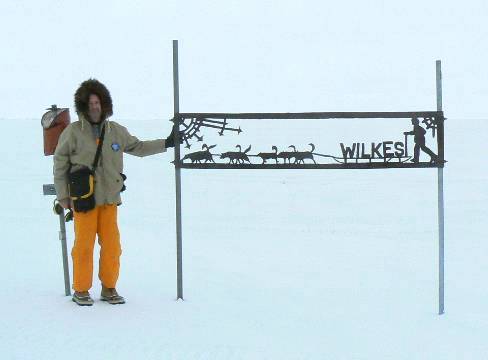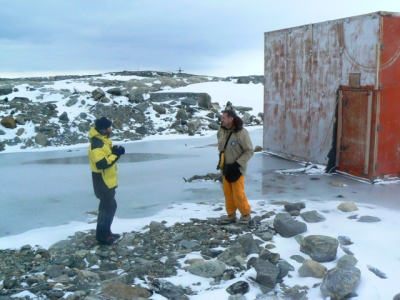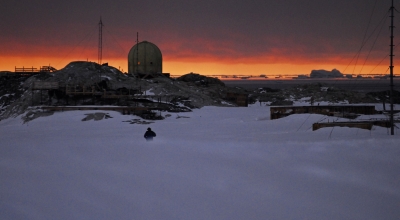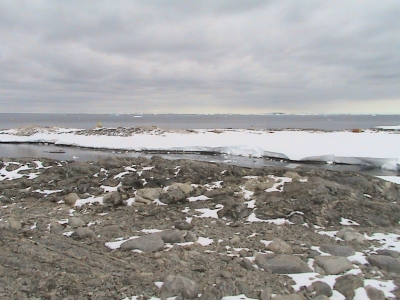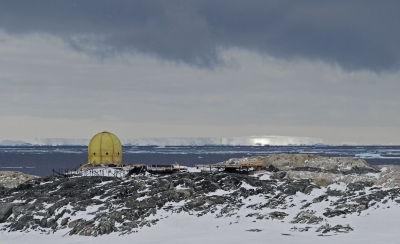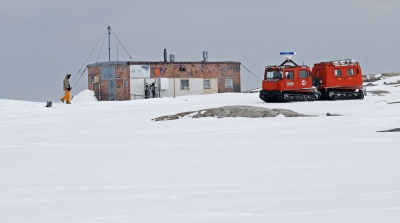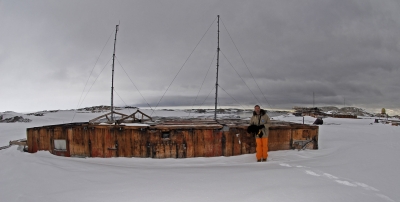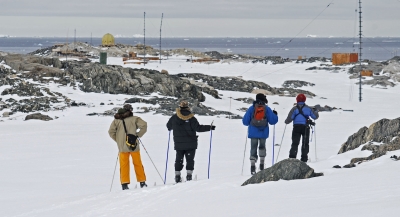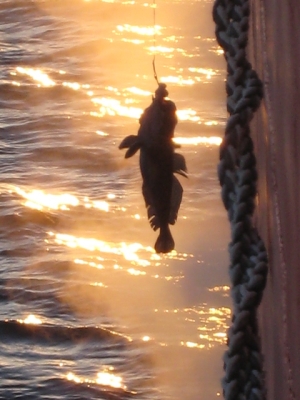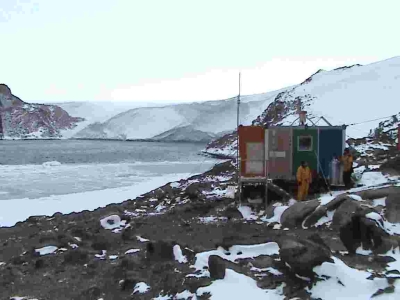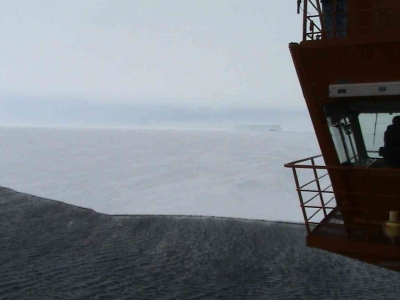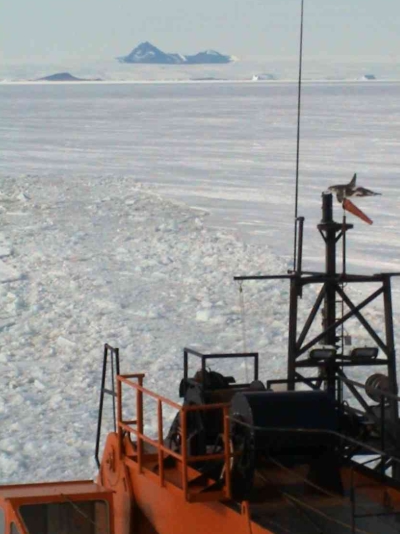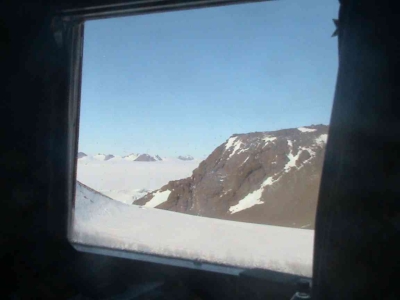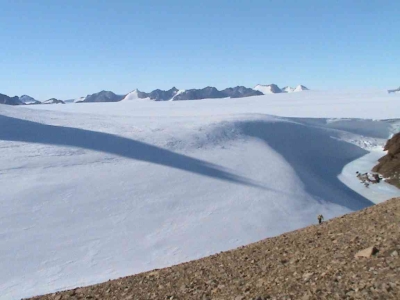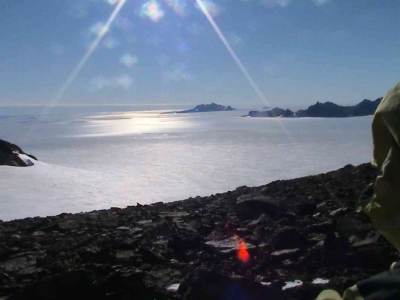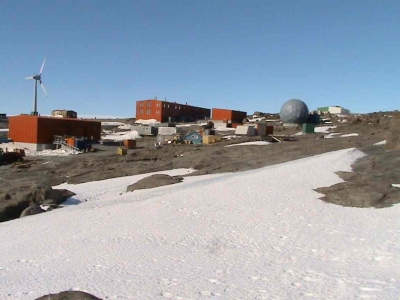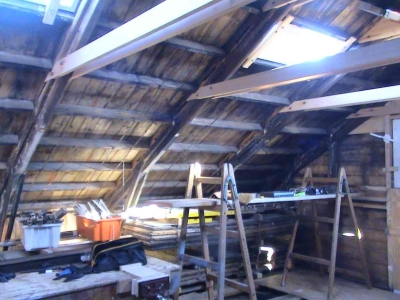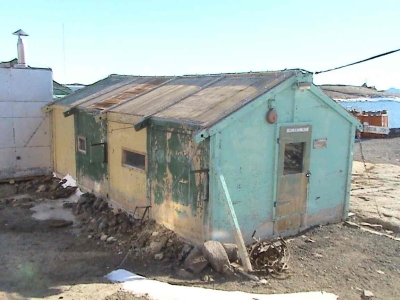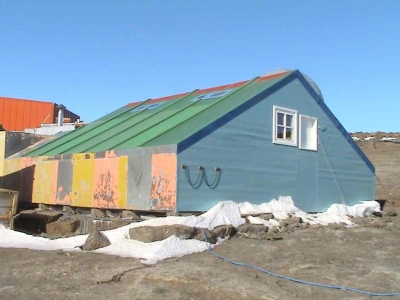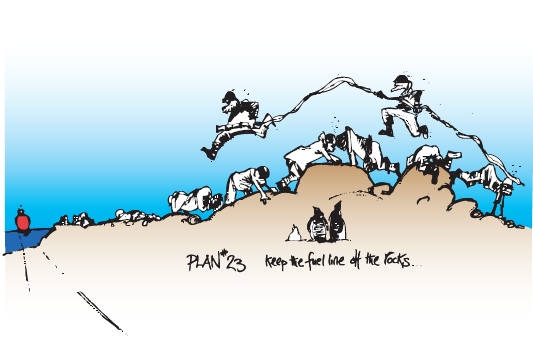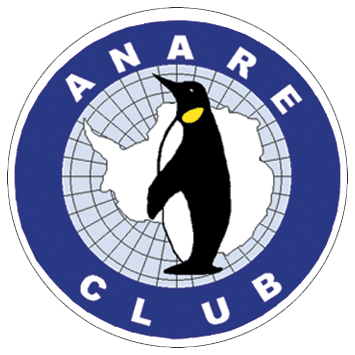A brash young, just 22 years old, and very raw Geophysicist, I was appointed to run the Geophysical Observatory at Wilkes for the year 1961. A lecture from John Bechervaise had fired my passion as a schoolboy, and the Director of the Bureau of Mineral Resources, as it was then, responded to my plea to go to Antarctica and gave me the job when I finished my basic degree at Uni. I was sent to the Mundaring Geophysical Observatory near Perth WA for most of the year in 1960 to learn how to drive the instruments and interpret the seismic and magnetic traces they produced.
So just over 47 years ago, I was aboard a little Danish Icebreaker, the Magga Dan, heading down the Yarra river from Port Melbourne for the big southern adventure. Then, I was a member of the Wilkes 1961 ANAR Expedition, all but one of our number, being first time Antarcticians. There were 24 of us, from predictably varied backgrounds and life experiences, and with a 16 year span of age range among us. Even our leader, Neville Smethurst – known as the OIC (Officer in Charge) – was among the younger bracket at 26. Wilkes had not long been seconded from the US (February 1959), and so we had 5 Americans in our party, 3 as Weather Observers and 2 Marine Biologists. We began to bond as a team on the trip down, and I recall the general feeling of relief when the little red ship departed, leaving US alone on OUR Station! Overall we had a very harmonious time, despite the Chief Diesel Engineer being ‘sacked’ in May and spending the rest of the time reading books. It was a testament to good leadership and the general level of tolerance of someone who had lost the plot in our tight knit community that indeed it did function so well. Two years previously, an expeditioner at Wilkes had “lost it” and was kept in a purpose-built cell until the Russians sent a rescue flight in to bring him out.
So what do I expect this time? Firstly, the 3 times larger ship will make the journey so much more comfortable, no matter what the weather throws at us! I hear the Aurora Australis is equipped with a Gym and sauna. What a contrast with the Magga Dan. One particularly bad night, while I was on the bridge doing “Ice Watch”, the Magga was rolling alarmingly from side to side dipping the wings of the bridge in the larger wave crests, and the Captain, Hans Peterson and I had just been served our half mugs of cocoa. Behind us the helmsman was fighting the wheel and the loading tilt gauge was ominously ticking loudly as the needle alternately slammed into the Port and Starboard stops set at 30Deg of list. We each had one hand firmly grasping the railing, feet well astride for balance, trying to manage sips of cocoa as we stared forrard into the spray and sleet. Captain Peterson turned to me with a wicked grin on his face and said matter-of-factly “Ah! My ship she is very good in zee ice, but not zo good in zee vater”.
Secondly, there is no doubt that modern communication will have removed the very real sense of isolation, the ‘romantic’ notion of being hardy explorers on an ‘expedition’ relying almost totally on our own resources. No more will there be any guesswork as to where the leads of open water are in the pack. You can see them on the satellite images, and plot your path through the ice. No more the head scratching from the navigator when the radar showed “land” some 50km before we were supposed to be there. That ‘land’ turned out to be a gigantic ice floe (30km long) calved from one of the shelves and drifting across our planned path. Technology at a high level of sophistication provides the template in the Antarctic parties of today, although I am sure the enthusiasm of the people, now happily not exclusively male, remains just as vibrant now as then. Particularly will this be true when we get in among the serious ice and begin to experience the amazing ambience of our surroundings. I don’t know how anyone can be unmoved by the experience.
So now, as a retired Medical Scientist, who still retains that enduring fascination for this magical part of our planet, I am very privileged to have the opportunity to observe the modern resupply process at our three mainland stations, Casey, Davis and Mawson and absorb every aspect of today’s “explorers” going about their various tasks, hoping I am able to assist in some of them.
As the opportunity arises, I will send back snippets of Antarctic life as I see it, to this web site.
#1 February 4 2008 52.33′ S; 132.09′ E
We’re almost halfway now on the first stage of our journey to Casey. apart from a fairly rough couple of days to start with out of Hobart to sort us all out – your correspondent was an early casualty of the ‘mal de mer’ – we’ve really had a dream run to Casey thus far. Betting sheets for the first iceberg are now up and the modal time seems to be mid Wednesday next. From initial observations it seems very clear to me that the ANARE spirit of old is well permeated through this latest generation of “explorers”. Sure the technology is different and the science more technologically sophisticated than it was in the past; and there is no question that the levels of comfort available are much higher, but the motivation,drive and camararderie of the present expeditioners are indistinguishable to that which prevailed among our own crews. Indeed the very fact they are still called ‘expeditioners’ remains a strong bond with the original ANARE. Perhaps it is not beyond the pail that the Club could diplomatically work on the senior politicians of the new government to reinstate ANARE as the official name behind each of the station and marine programs. Thus even though some might only stay a few months, each segment of the program could be an ANARE “summer at Casey” or whatever is its function. It is significant that there is a strong urge among the newer explorers to link with the old and some have even had shirts embroided with “60th ANARE at Casey” to make the point. Funny you should mention the water over the porthole! We did a small course correction after tracking into the swell to allow checking of the container fastenings – we had a rough night last night – and I was having a cuppa in the library when we did a massive roll! I reckon the porthole was a couple of metres underwater!!! I am working on blog #2. There’s a wealth of good yarns down here isn’t there? I reckon we could fill Aurora’s for years with interesting stories.
#2 February 5
As we pass through the middle of the ‘furious 50’s’ the Southern Ocean has turned from a relatively benign organism into a ferocious, wild spray-filled tormentor of ships daring to traverse her randomly heaving surface. The barometric pressure has taken one of those sudden drops to near the bottom of the scale, ever the harbinger of bad weather. As I finish this off next morning, we are a haggard bunch of intrepids who had little sleep alternately being thumped on the head and feet – human shuttlecocks in our bunks, being played with by the wild waves. On the brighter side, yesterday two whales were sighted off the port bow – always a smile-inducing event. This morning I learned about the 500 Club. This is a select body of ‘explorers’ who have spent 500 days or more on the Antarctic continent. So it does not include travel to or from, but it can be accumulated over multiple short stays as well as long ones. One fellow I’ll meet at Casey has qualified 3 times over, and by the anecdotes I’ve had should be the subject of a great yarn in Aurora. The ANARE Club should liaise with these folks to see about some kind of recognition which of course will also apply to many of our old timers. Another story told me this morning was about the last of the VW buggies at Mawson. Apparently the AAD had been trying to get it RTA’d for years, but when the ship was due in it would have mysteriously vanished in a blizzard, only to be ‘rediscovered’ some time after it sailed. It would seem some of the folks would dig a deep hole and bury it in the snow out on the hill away from the station, but have a GPS marker of the spot. Then they’d go and recover it when the coast was clear! I understand the ‘system’ finally won out a year or so later. I hope to find out the ultimate fate of the BSA 125cc motorbike I had at Wilkes in 1961, while I am there. I handed it on to Pancho Evans when I left I think, but have heard no more.
#3 February 6-7
Late this afternoon our first iceberg emerged out of a grey mist off the starboard beam about 3km away. Your correspondent narrowly missed the sweepstake prize, being pipped by his cabin mate Peter Corcoran, ex Davis 1997 and now travelling as the Voyage Management Trainee, cheerfully known by the acronym of ‘vomit’. seeing it sent a thrill even through the many hardened polar travellers on board, and this well-sculptured specimen, holding a seemingly disdainful calm in the stormy sea breaking against its blue/white cliffs, was an entirely appropriate subject for the many pixels of data consumed to record her passing – like ships, I am sure they are best addressed in the feminine gender! Another event for the day was the “crossing the line” visit from King Neptune and his helpers. Your correspondent thought he was immune from their attentions, smiling smugly as these youngsters were put through his team’s rituals. But such is his dictatorial nature, King Neptune decreed that all those who had not passed through 60degS in this ship were required to be re-initiated! We had to make much supplication to the King, then taste some foul liquid, be smeared with some very fishy pottage, kiss a large gutted fish, and eat a royal haemharroid. Fortunately this last item was in fact a red wine grape! The crew went to a lot of trouble to conduct the ceremony, which was appreciated by all the onlookers at least. The newly inducted subjects retired quickly for a shower! The weather has been overall moderate these last two days making progess fairly rapid, and sleeping not the shuttlecock experience it had been! We’ve just passed through 61.45S and 116.44E with some predicting we could be at Casey as early as tomorrow (Friday) lunchtime.
#4, February 8 65.32S; 109.09E in the pack at last!
Two days ago, some wag was spreading a rumour that we were actually somewhere off the NSW coast because we had not seen any ice, then the first iceberg, then nothing else for a day. But today its all happened in a big way. First a scattering of very reasonable tabular icebergs, with their individual trails of scattered bergy bits, then small outcrops of old pack, then finally some floes and a little clutch of Adelies to welcome us. They were new guys themselves as there were lingering brown moulting feathers on their backs and they did not quite know how to handle the red monster nudging their platform out of its way. So the solution was a spontaneous group dive into the sea. Shortly after came our first seal, a Crab Eater, who was equally nervous deciding not to wait for his floe to be nudged. He slithered to the edge and gracefully slid into the deep blue water. All the while small flocks of Antarctic Petrels and the odd sooty Albatross are surveying our giant grumbling floating red steel capsule. Now we are pushing through fairly heavy broken pack at about 4 kts, just 5 nautical miles away from Casey. This alone has revived everyone’s spirits, folks pass each other with a big smile in the gangways, silently sharing a wonderful uplifting experience. Even among the multi-trippers, there is an added sparkle in the eye and a lightness of foot. We are undoubtably in Antarctica at last. Today also marked the time for us to perform a thorough vacuum clean of the clothing that we are taking ashore. Some of us volunteered to do the “IPY clean”, part of an international survey of “Alien life forms in Antarctica”. Special filters in the vacuum cleaners captured what was found in our pockets and velcro straps and camera bags and day packs, and these were all combined with a questionnaire so that individual samples could be traced back to geographical locations elsewhere in the world in the recent past. Australia is playing a leading role in working to keep Antarctica free of introduced organisms. It might seem like an overkill to some, but its a small price to pay if it stops any spread of foreign living things.
What an amazing sight, sliding gently into anchor off Casey station at 07h00 February 9 in a dead calm sea, mainly an overcast sky, with the meteorological Radar dome at Wilkes and some of the old radio antennae cleary visible across the other bay, off the stern of the ship. From the bow, Casey looked like a huge mining camp complex scattered around the hill at the head of the bay. The current Station Leader, Jeremy Smith, came out to the ship and gave us a detailed briefing of things happening at Casey, especially the do’s and dont’s moving about with all the heavy machinery trundling around during the resupply. Later in the morning most of us going ashore were ferried across in the barge to our allocated accommodation in the big red shed. The first impression of what I imagine an arctic mining camp might look like was reinforced once we got into the base proper. What a massive high tech operation the station is! And what luxury is the Red Shed – like a 4* hotel! For all that, it was very pleasing to see the ANARE lettering on almost all the machinery, usually as part of the roundel logo we old timers were used to – keeping the link through our long history well and truly alive. Even in the 2007-08 Casey Handbook prepared by Jeremy Smith for the proposed visit of the G-G, he refers to the current operations as the “61st ANARE”.
Former Wilkesians will be delighted to know the red shed – the main accommodation module and heart of the station – is well percolated with photographs and even a special exhibition of artefacts, from those good old days in the “banana belt” of Antarctica! It was a thrill to your correspondent to see so many of the 1961 photos hanging in pride of place there. To cap the Wilkes experience, I was included in a party of 6 yesterday afternoon to go to the ‘Wilkes Hilton’ for an overnight field trip “jolly”. The Wilkes Hilton, complete with sets of slippers supplied by the hotel chain, is in fact the new transmitter hut our 1961 party assembled that first summer we arrived. It took us about 45 minutes to travel the 7km by a tandem Haaglunds vehicle, and on arrival we did an extensive walking tour of the old station. It was an extraordinary experience that will remain an abiding memory, revisiting a place that effectively transformed my life, but was now a derelict abandoned ruin! Without exception all the buildings were filled with ice and snow, completely inaccessible, but the aura of its previous vibrancy was still almost palpable for me as I walked around on the roofs pointing things out to the others. One of the urban myths doing the rounds is that there is a piano still buried in the ice of the recreation hut. Unless a piano was brought in after our time and somehow left behind, I assured folks there was no piano in 1961. Perhaps a reader might care to comment and either validate or refute the myth. After a simple but nourishing meal heated on the gas stove by our very enthusiastic, wonderful guide, Vonn Keller, a very comfortable night in the Hilton followed, for three of us, as three others decided to try the bivouac experience outside. One, Craig Cormick, claimed he was attacked by a penguin during the night, but the absence of tracks tended to dispute this, and it was generally agreed he had been dreaming! As he is a journalist, we felt he was building up a story for the tabloid press. Next morning we skiied over to the graves of Robinson and Sullivan to pay our respects, then did an extensive ski tour around the greater Wilkes area, noting the large number of empty fuel drums blown by blizzards into all sorts of nooks and crannies over the years. Finally after lunch we did another extended walk through Wilkes station soaking up more of its ambience, then headed back to Casey in the Haaglunds. The weather throughout remained calm but overcast with a ribbon of clear sky out over the sea generating first a spectacular sunset, then next morning some brilliantly illuminated large icebergs parading in a line from Cape Folger in the North. There seemed to be a vastly greater number of bergs in that line than we had 47 years ago. Another sign of global warming?
#6 February 11 at Casey
Just a quick update before a small party of us heads out to “Robbos” a field station at Robinson’s Ridge, some 15 km South of Casey. It was named in honour of Hartley Robinson who was killed in a tracto accident at Wilkes in July 1959. Our journey will be another overnight stop, mainly for moss sample collection by our experts. for me, it will be just a very pleasant “jolly”. My comment about the mythical piano at Wilkes has already been refuted by our Doctor, Lloyd Fletcher who crawled into a tight space through an opening in the roof of the old recreation building back in 1986, when you still could, and saw a piano and movie projector through the clear ice within! Today, I had volunteered for “slushy” duty along with Andi Smithies, Head Librarian with the AAD. We were kept pretty busy most of the day with he usual kitchen hand chores of washing up all the pots and pans generated by our Chef, cleaning tables and mopping out the dining area after lunch, refilling various containers of cereal and biscuits, and so on. But with 2 hours off during the afternoon we had the opportunity to walk around this extensive station complex and get some good photos in what was a perfectly clear sunny day.
#7 February 14, passing through “iceberg alley” en route to Davis.
If ever we needed reminding of the state of modern communications, two elements were highlighted yesterday. Firstly, an e-mail was circulated reminding expeditioners that orders for flowers through Interflora for those who had not prepared their Valentine’s token in advance, would close at midday. Secondly, there was some debate about the significance of the iceberg at the entrance to Mawson’s horsehoe harbour for our resupply of the station when we arrive there in a week or so’s time, as we watched it ‘live’ on the webcam from the comfort of the Casey library. These past two days I have had the privilege of being on a ‘jolly’ over to Robbo’s Hut some 15 km south of Casey. It is a little red field hut out on a ridge named after Hartley Robinson who tragically died in a tractor accident at Wilkes in 1959. Four of us journeyed out in a Hagglunds vehicle going via moraine lines so that moss samples could be collected by Anja Steinwender and Antek Skotnicki. Our expert guide was Nick Cartwright, a very competent and experienced fellow from Casey and a delightful travelling companion, whose day job was as a Carpenter/Builder. The weather was mainly overcast but calm, with an estimated temperature of -12C overnight. When we arrived, the sea below the Hut had that greasy pre-freezing appearance, and by morning this had thickened into sizeable pancakes several cm thick. While the moss gatherers rolled their stones, Nick and I had the unmitigated joy of just sitting on a rock a few
metres above a clutch of adelie penguins who were in that restless niggly stage of final moulting. The newly formed sea ice was gently surging to and fro on the coastal rock shelf below setting of a light crackling sound in the otherwise infinite silence that so characterises Antarctica. Occasionally, we heard a louder distant gun-shot of an iceberg calving from the Vanderford Glacier a few km away.
Last night there was a special handover party at Casey, where the ceremonial keys to the station were passed from the Summer outgoing station Leader, Jeremy Smith to the incoming wintering Station Leader, Bob Jones. Former Wilkes explorers will be delighted to know they still call the secure grog store “Fort Knox”, complete with a real key, included in the handover. Also I learned that the local radio station known as Radio KOLD, is perpetuating the name coined by Steve Grimsley for his station at Wilkes in 1961. These minor examples illustrate what is a real hunger for history among today’s expeditioners. On numerous occasions in the past few days at Casey, expeditioners have come up to query me on many different aspects of life at Wilkes. There was a poignant moment too, when on responding to a question about my feelings on revisiting Wilkes, one listener commented that at least there was a relic to visit! He was at Casey 1 in 1987, and it was completely dismantled and returned to Australia when the new station opened. One building at the top of the old station, the workshop, still stands on the eastern perimeter of the new Casey station. But that complex of tunnel linked buildings, so characteristic of old Casey is not there to trigger memories.
#8. February 17
At sea on the way to Davis. Soon after leaving Casey we entered broken pack ice, then out into clear water with occasional icebergs, then back into such heavy pack, sticky with new falling snow, we had to do a bit of a turn back north to get clear of it. Night-time in heavy pack and drifting snow with the ship’s searchlights scanning out front, seeking out a likely lighter patch or watery lead, and all the time 10 million watts of diesel power is throbbing through our red floating steel capsule churning ice floes into mush off the stern as in a giant blender. What an awe-inspiring demonstration of technology fighting nature, and only just winning! Now we’re out in benign open water cruising along at 13 knots, with several pods of humpback whales sighted, some breaching within a few tens of metres of the ship. Just this last few days in addition to the whales, we have seen Weddel seals, a Ross Seal, penguins – both Adelies and Emperors, and one particularly aggressive leopard seal, who, as we scraped by his floe, became very agitated, barking at us like a guard dog, while standing his ground. Is it any wonder so many of us get hooked on Antarctica once we have experienced it?
REPORT No. 5
Hi All, Weather forecast from down South, we had to change Heading due to a gale force 10, & wave up to 12 metres, so now we are going slow & heading North West & away from Casey. Also the weather does not look good at Casey & the Ship is unable to get in close & due to the Ice, it will probably reach 90 km from Casey & will have to pick up 42 expeditionars by Helicopter. This has set the program back & some of us are disappointed, But as the Captain said He doesn’t want to make Aurora Australis a winter Station. We can only hope that the weather changes & we can get in closer Regards Phil
#9 A fishy story
One of our barge skippers, Les Sims, a professional mariner, wooden boat builder and fishing tour operator from Hobart, obtained an official permit, and could not wait to indulge his passion when we anchored at Casey. Here he is fishing from his cabin porthole, and proof of his skill! My cabin mate Peter Corcoran, captured the evidence.
Well I have planted it at Platcha – insider’s joke! Its been a fairly ‘different’ few days compared with the original plan outlined by our ever-cheerful voyage Leader, Nicki Chilcott. We arrived at Davis to a beautifully calm morning, with little clutches of penguins on ice floes playing chicken with our slowing but inevitably overpowering orange steel juggernaut, Aurora Australis. And as soon as we were ‘barged’ ashore, three of us, Ross Harwood (AAD Logistics Officer), Andi Smithies (AAD Chief Librarian) and myself were taken by Station Leader, Peter Petersen up to the helipad and flown out to Platcha Hut in the care of Glen Hoger from Davis who is an Air Operations Ground Support specialist and a very experienced field guy. He has been at Davis since October 2006. By the time we reached Platcha, a most picturesquely sited little Hut – well two Huts actually, the original one now almost entirely given over to house the toilet and two emergency beds, and a few metres away, the later one built in September 1982 – the wind had risen considerably. We only had time for an hour or so wandering around the area, admiring the kaleidoscope of different boulders and stones in the rocky landscape scoured out by past eons of ice abrasion, the plateau ice cliffs a mere 50m from the Hut, and the head of the fjord, now ice free, just about 20m in the other direction.
Come lunch time we were tucked up safely inside our reverse freezer box coccoon, from where we were effectively confined by the ever stronger gusting wind for the next two days! Glen estimated some of the gusts were reaching 50 kts, and they certainly gave the Hut a good shaking on its steel guy tie downs from time to time. During two of the comparative lulls, I enjoyed being just a little intrepid by going out and collecting buckets of ice for water-making from a nearby drift bank. It was important to scrape away and discard the surface layer first to eliminate collecting the frozen salt spray flung up from the waves crashing against the ice edge below the hut. The four of us, above average sized males, quickly became adept at moving around the confined space, a very necessary skill, as our boundaries were an overall 3.3m square already partly filled with two substantial double bunks, food shelf, stove, sink and a table and bench! Needless to say, the bulk of our time was spent lying on our beds. The winds moderated enough by lunchtime on the third day for the expert helicopter pilots to negotiate the still pulsing winds and land cleanly on the little helipad nearby to take us back to Davis.
Once ‘home’ we learned about the other dramas affecting both another field party and the ship in the adverse wind conditions. One woman on another field trip broke her arm and had to be airlifted back to Davis, the ship dragged on her anchor and had to go back to sea to do ‘laps’ up and down the coast for the time, only arriving back at Davis this morning to get us all back on board ready for the last port of call, Mawson. As you might imagine, the resupply was significantly delayed, so the teams are working flat out now to make up as much time as possible.
So in the few hours spent at the station at Davis, I have enjoyed the very welcoming hospitality of the team there who, just like those at Casey, are fully imbued with the ANARE Spirit and its history, an unbroken continuum dating from Heard and MacQuarie Islands in 1947. It was especially pleasing to be taken on a guided tour by Ray Morris of the latest Physics experiments involving both basic geosciences, like magnetic field variations, through interferometry, all the way to the spectacular LIDAR pulsed laser work unlocking more evidence of probable climate changes in the very outer reaches of our atmosphere. The sophistication of the technology, and the enormous download of data these computer-controlled instruments generate, completely dwarf the fully manual, basic instruments of our time. Our Antarctic science is world class, being performed at stations of world class in the harshest climate our planet can generate.
#11 en route to Mawson February 24-26
This leg of the voyage has been a mixed bag from pushing through thick pack, cruising North up close alongside the big berg from the Ross ice shelf for many km – someone had estimated it held enough water to keep Sydney going for 400 years, the only problem would be getting it there! – some open water then as we headed mainly West, and now back into pack as we head due South into Mawson.
Most of us have been reading, watching the odd movie, but importantly there have been some afternoon lectures of considerable interest. Dave McCormack has been making a detailed history of the “Weasel” over its life in the service of ANARE, and gave us a most interesting illustrated talk he called “Weasels I have known”. His passion for preserving what is left of the weasel fleet radiated from his discourse, and he focussed strongly on the so far fruitless search for Bob Dover’s weasel #3 that was abandoned by John Bechervaise’s team 200 km from Mawson when it broke down in 1955. Only the engine was removed, the men being towed home on sleds by the remaining weasel, camping in tents and lugging the engine along with all their other goods. Major hi-tech surveys have been undertaken over the years to find this weasel without success, despite its position being known to within a search area 1km by 2km, recommended by Syd Kirkby. But it is buried sufficiently to defeat discovery thus far. Dave certainly had his large audience enthused with the heritage value of finding this machine for ultimate conservation in a future museum of Australian Antarctica.
By way of complete contrast Gary Miller gave us a very erudite presentation on the project he and his partner Robyn Mundy will be conducting with the Emperor penguins at the Auster Rookery out of Mawson this Winter and Spring. They are seeking to piece together evidence for why the penguins seem to carry anti-bodies for a specialised virus common to domestic poultry in temperate latitudes. There is no obvious mechanism by which the birds could become infected by this virus, and unravelling this could also help to understand other viral transfer mechanisms in isolated colonies like these. Its going to be a very technically challenging task for them taking blood and faecal samples, especially during the coldest time of the year. But they have had some years of practice, from King Penguins at Macquarie Island to Skuas at Casey. The extra size of adult emperors will no doubt make it more daunting.
Well we have just come up against some fast ice a few km from Mawson, there’s a fierce wind blowing and the dark streak on this shot shows a cluster of penguins sitting on the side of an iceberg just off the port side of the ship.
#12 Tantalisingly close to Mawson February 28
What a beautiful sight this morning! A sunny perfect windless Mawson day. One can well understand why ex Mawson ‘explorers’ drool over the awesome scale and natural beauty of the station setting, especially with this big patch of fast ice out front, the various discreet mountain ranges starkly piercing the snowy plateau backdrop, and a line of icebergs guarding the coast. The only problem for us is that we have been bashing our way through a barrier of thick fast ice since yesterday am, so not much sleep last night. Aurora Australis is really guzzling her fuel from the effort of it all – about 40 tonne per day – double the usual cruising rate. Each 100m charge into the ice has only gained us about 50m. At last count we had made about 4km with another 20 to go! But helicopter operations have now started with the first run being to deliver mail and fresh food, returning with the Station Leader, Narelle Chapman, for a briefing for all those going ashore. If all goes well with the weather and operations, three of us will be taken out to a field hut at “Fang” Peak in the David Range, some 30km SW of Mawson for a night followed by a further night on station. Yet another wonderful mini adventure in this ever shifting kaleidoscope of Antarctic experiences.
#13 Mawson -Rumdoodle – Fang – Mawson Sun March 3.
The dream “Jolly” continues while the “A” factor bedevils the resupply operation! Three of us, Peter Corcoran (remember VoMiT!), Andi Smithies and myself, shoehorned ourselves into the immersion flying suits with some necessary help and were helicoptered into Mawson around 10h00 local time Friday. There we had time to help our guide Rob Brittle (Field Training Officer) with some preparations for our field trip to Fang Hut via Rumdoodle. We had a little time to explore the station first while he delivered another group to “Hendo” (Mt Henderson) in the one Haaglunds unit available, returning to collect us. Then it was off over the endless expanse of blue ice streaked with long broad splashes of white, up the edge of the plateau and over to Rumdoodle to deliver a primus stove and share a brew with another party doing a field training course. What a sight those dessicated rock pinnacles are, piercing the plateau’s ice fields like jagged offset serrated teeth in a giant shark’s mouth! And it just kept getting better. We buzzed across from the Rumdoodle serrations to the David Range serrations and one sharp edge in particular, the appropriately named “Fang” peak. Through a gap between the teeth, we turned right up a long snow bank complete with an intricately sculptured wind scour that must have followed the vortices of wind around the curved rock face which dropped into a large frozen meltwater lake about the size of a big ice skating rink. Where the snow bank ran up into the rock scree is Fang Hut tucked in the lee of the Fang itself. Fang Hut is a very cosy little structure, smaller than Platcha, so 4 large males had to sashay around each other, taking it turn about even to change clothes. But we settled in quickly, and Rob soon had a fine meal of a tomato-based ‘soup’and cuscous, preceded by biscuits and cheese, set in front of us. It was gusting and overcast when we arrived, and overnight the INSIDE of the hut went to -9deg, as the gas heater is turned off for safety. But next day dawned without a cloud in the sky, although the wind remained around 50kph, and before being collected by the helicopters we had two magical walks, one to the ridge line leading up to Fang peak from where we could look back to Rumdoodle, and the other across the snow bank to the ridge overlooking an expansive valley of blue ice and many crevasses across to the Casey Range. No words I can find are adequate to describe the awesome spectacle of Nature at her most majestic, yet seemingly serene icy best. We all just sat there entranced and humbled by the timeless infinity of it all, noting how our presence in place and time was unregisterable on the scale of this landscape. I am sure even our best photos will not do justice to the whole aura we imprinted in our memories on that ridge line. But I include 3 as a sample of what we saw.
One, from the window of our hut after the -9Deg overnight ice crystals had cleared, the second looking back down the long snow bank to the South Masson range, and the third from the Fang ridge into the sun across the plateau towards Rumdoodle in the North Masson range. Even the helicopter ride back to Mawson was special as we were taken over the wreck of the Russian plane, equivalent to our wartime DC-3, that blew away from Rumdoodle many years ago, presumably while the Russians were bivouacing there with one of our parties. It became lodged in one of the many crevasses in the area, a total wreck, and there it lies still. I heard part of a story about one of our teams trying to recover an engine, but lost one of their vehicles in another ‘slot’ on the way out. There’s an intrepid yarn in there I am sure!
#14. Mawson March 3.
Ex Mawson ‘explorers’ are renowned for their bias, referring to Mawson as “The Premier Station”, and now I would have to say that in terms of its overall setting and strong links to its history, this is not unreasonable bias at all. Having now visited all 3 mainland stations in short order, there is a stronger visceral feel about Mawson as a polar outpost with a long tradition than was evoked by Davis and Casey. Informal chat with other unbiassed travellers on this voyage indicate similar feelings. Its a coalescence of factors: the compactness of the buildings around Horseshoe Harbour with the immediacy of the plateau and those wondrous mountain ranges behind; the way the new buildings wrap themselves around the original structures of Biscoe and Weddel Huts as though cherishing and protecting that history; the creation of the “dog room” on the scenic end of the Red Shed upper floor looking out over the harbour with its guard dog at the entrance, dog photos on the walls and a fully laden sled inside, all dedicated to the memory of the Mawson dogs; and even the pseudo heritage wooden box filled with -dare I say lovingly -restored “Playboy” centrefolds rescued from the ceiling of one of the old huts and now placed at the head of the stairs leading to the bar and rec. room. There’s a very real sense of living history here, from the wharf and the walk past the bronze bust of Mawson by the flag poles, to the various mooring bollards where ships have tied up here over the years, even to the scatter of seal bones along what had clearly been the dog lines of old. Back to the East, there is the old aircraft hanger still in good shape, and seemingly being well maintained.
I had the privilege of a personal guided tour around the old buildings by the Heritage Carpenter Mike Staples, who is doing a superb job restoring Biscoe Hut after a near disastrous fire some years back. Mike is funded from the insurance payout after the fire, but is really concerned that even this wont fully cover the outlays needed to complete the job. [See note below on origin of Biscoe]
Mike has successfully restored the structural members, but he would like to have any photos of how the inside was laid out in terms of the partitions and other fittings. If anyone knows of photos of the inside of the Hut which could be made available for the restoration project, Mike would love to hear about it. Biscoe is linked via a sealed 2m long section to “Weddel” Hut, which was one of the original Australian made modular wooden huts shipped to Heard Island in 1948 and relocated to Mawson in 1954. The unique feature of Weddel is that every panel is identical so it could be placed in the roof or wall. However, time and weather have played havoc with the structural integrity along with some modifications made to the hut, with the result that Mike is concerned about it collapsing in a big blow. There is no plan to restore this hut, and perhaps this is where old Mawson explorers could offer some financial aid through bequests or up front donations to ensure the Weddel-Biscoe complex is retained as a heritage site. Mike said the linking section housed the early Met Observers equipment, another element of history to be preserved.
I have chosen this non-traditional Mawson photo to exemplify the link from the old to the very new in the 54 year story of Mawson. The other shot is taken of the inside of Biscoe Hut. Biscoe and Weddell.
Note: Biscoe had come to Mawson from the Norwegian, British, Swedish Antarctic Expedition, 1950 to 1952. It had been left on the wharf at Capetown, when there was no room on board their ship the “Norsel”. Bill Storer advises that a basic construction was done at Tottenham before sailing and at that time it was known simply as the NBS hut. The interior layout in 1954 was five bunks down each side for the party of 10 winterers, a stove and sink draining to a 44 Gallon drum outside on the Western end, with a table in the center. A porch was constructed outside the door at the Eastern end, containing the Dynes weather instrument, and the toilet.
Above information from conversation with Bill Storer today, and from Phil Laws book Antarctic Odyssey. Leader J Giaever tells the story of the NBSAE in his book The White Desert, including construction of an identical hut at their Maudheim Base. Colin Christiansen 5 March 2008
#15 The home run.
What a way to leave Antarctica! Flares rising into the sky from Mawson Station, pancakes of new ice forming to herald the refreezing of the sea in Kista Strait, a biting cold Katabatic rushing down from the plateau to send us on our way, then the shadow of the ship panning over the pale redness on nearby icebergs in the setting sun, as we thread our way north through iceberg alley towards Hobart.
Its no surprise then that the men and women of the 61st ANARE are being infused by the same spirit I was on the 14th ANARE at Wilkes in 1961, and it no doubt remains effectively unmodified since the very first ANARE in 1947. That spirit in turn is a direct descendent of what first drove the original explorers to Antarctica, of that I am sure. It is ageless and self-sustaining as long as we keep our stations in operation on this uniquely beautiful continent. You can see it in their eyes, their whole bearing; they are a class of people quietly and unconsciously set apart from others by what they have seen and done as a shared experience, whether it be only via round trips, summers, or the ultimate, a winter in Antarctica. As one fellow traveller put it, “you cannot really find the words to describe what Antarctica does to you, it has to be experienced”. All around me ‘explorers’ are talking of their forward plans, a winter or another summer down here, yachting and other adventures in far corners of the world, or simply going back to live in remote or wild places in our own country. Not for them a permanent routine 9-5 working day, topped and tailed by a stressful commute in a big city. That’s for ordinary folks who have not been lifted onto that higher plain an Antarctic sojurn inevitably creates. New friendships forged on the ice are being reinforced by exchanges of addresses to all points of the compass linked with promises to visit. While there is a mounting excitement for home now, especially among those who have just done the long haul at one stretch, like 2 summers and a winter, many are feeling a little wistful about our leaving, and even somewhat envious of two who have been given the chance to remain at Mawson for the winter at the last minute.
Our immediate Past President, Syd Kirkby, penned a most eloquent piece on the ANARE spirit for “Aurora” as part of the 50th ANARE celebration (September, 1997). It was reprinted in the Club’s Jubilee book, and an excerpt is appended below. I stongly recommend a re-read of it to remind us all of what its about. Syd’s name and reputation have been much in evidence on this voyage as his biographer, Lynette Finch, has herself been absorbing that all pervasive spirit while she visits the stations, and especially the field huts like “Hendo”, “Rumdoodle” and “Fang” at Mawson so that all her senses are well tuned to the ambience for writing Syd’s story. What is a particular joy, is the degree of interest in the long tradition and history of ANARE: the pride with which many wear station logo shirts embroidered also with “61st ANARE”; the large turn out to presentations about Wilkes all those years back; the many questions on station life in those times from the current generation, and the 20 new enrolments to the Club already on this voyage with 9 days to go.
It has been an honour and a privilege to represent the ANARE Club for this voyage. I thank the NSW Branch for my nomination. The Voyage Leadership of Nicki Chilcott, Rob Bryson and Peter Corcoran saw to it that my journey was made so memorable, as did the Master, Murray Doyle, and his crew on ‘Aurora Australis’ who are well integrated with the expeditioners. All the men and women of the 61st ANARE on the voyage and at the stations made me feel a welcome participant in their adventure. Finally, on behalf of the club I wish to express my gratitude to Tony Press and the AAD for making the whole trip possible within a busy resupply program.
Bill Burch
The Spirit of ANARE
The spirit is there because we shared the wondrous glory of it all; the heave and swell and crash of the Southern ocean, the roller coaster ride as the ship falls off the top of a swell and buries its nose and half its foredeck into a steel-grey sea and, even though we know she will rise out of it, holding our breath until she does…….the exquisite colours of blue – ice cliffs and crevasses and pack ice below the water – and the inexpressible serenity of ghosting along in a dead calm pool amongst the pack; the raucous challenges of the Adelie penguins, and the stately bearing of the Emperors; the sudden explosive ’whoosh’ of a killer whale blowing beside the ship or more excitingly beside us in a small dinghy… Not all of us knew all aspects of the ‘spirit’, but we knew enough personally, and knew enough of other aspects by account, to have it as a shared experience. Even more, the spirit is there because we each know that fellow expeditioners, like oneself have been where the spirit is born, that they have seen and done the same sorts of things and therefore must share many of the same values. We are fortunate enough to have had opportunities to step outside mere personal interest and by contributing to a bigger undertaking to reap a bigger reward. We have had the chance to transcend our ideas of our normal capabilities and be a bit more committed, a bit less selfish, a bit more diligent and capable and stalwart and inventive and compassionate and versatile and determined and to the surprise, I’m sure of many of us, we mostly took those chances and lifted our game. And because we committed ourselves to the dream we shared in its realisation.
Syd Kirkby 1997
